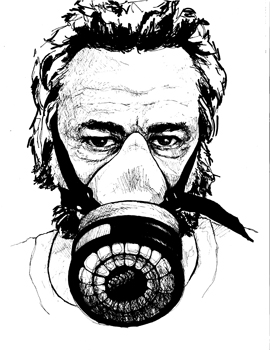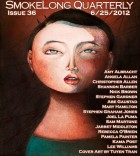How did you start writing this story? What inspired it?
My novel just coming out, Growing Up Dead in Texas, I realized I didn’t have a dedication for it. Some novels, before you’re done, you know who they’re for, or against, or targeting. This one, though, I couldn’t think of anybody’s name to put up front. Who wouldn’t be insulted or take a contract out on me, I mean. But I sat down anyway, kind of wondering who I would be dedicating it to, were there going to be a dedication. And I thought of everybody, of course. And, I didn’t realize it at the time, but I was completely stealing from Michael Kimball, his Dear Everybody. I shot it to him while it was just an hour old, and he agreed that I was a complete thief. That’s when I went back through, put his name in there. Doesn’t make me any less of a stealer, but it lets me feel a little better about it, anyway.
Is there any truth to this dedication? Or is it straight fiction?
A lot of truth. One name in there (not Michael’s) I so should have known better than to use. Don’t know what I was thinking. I spend a lot of time terrified she’s going to see it. Or ‘he,’ I mean. Or them.
Have you had to write a real dedication before? If so, was it easier or harder than this fictional version? If not, has this story better prepared you to do so in the future?
Guess I’ve done dedications twelve times, now—ten novels, couple of collections. Plus Growing Up Dead in Texas, I think. I suck at keeping count, though. And, as soon as I figured it out, I’ve been rigging all my dedications with a top and bottom story. The top’s for somebody with, like, a social security number, a birth certificate, and the lower’s usually to one of my characters. Either published or not published. My first dedication ever, though, for The Fast Red Road, it was originally ‘for Gerald Vizenor’—he’s one of my heroes (him, Joe R. Lansdale, Stephen King), but then, surprise, my publisher shot that book to him for a blurb, and he came through with one, so I had to scramble in at the last moment, change it, as I thought it’d make it look like I lured him in to do the blurb.
It seems like pain and art go hand in hand, like in the case of this narrator. Do you think it’s possible to make great literature or art if you don’t carry this level of pain, disappointment, disenchantment?
Man, I think everybody’s got some level of pain, disappointment, disenchantment. If all you’ve got’s a little, you tend to magnify it up, and, made big like that, it’s something you can translate to the page. But, trick is, I think, whatever you’ve got, it never feels little. I mean, I can play my life up as, I don’t know, TJ Hooker’s sidekick, such that I’m always taking bullets and rolling off of moving cars, but that’s light duty to the guy standing behind me in line at Burger King, I’m sure. And the guy behind him might have just teleported down from an exploding starship, and be carrying the last memories of his now almost-extinct race. And on and on. But not all of us’ll be writers, either.
“Now turn the page. Start the story.” What kind of story would this narrator be telling? What type of book would this be?
Growing Up Dead in Texas. Maybe my Bleed Into Me. Demon Theory. Or any of them, really. All of them. Every novel and story’s wildly personal, intensely autobiographical, hardly made-up. I don’t know any other way to do it.



 Included in the price of SmokeLong Fitness:
Included in the price of SmokeLong Fitness: